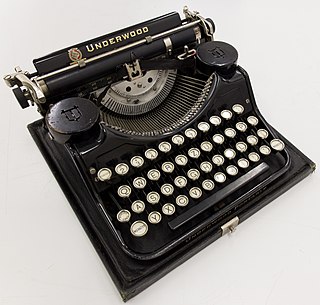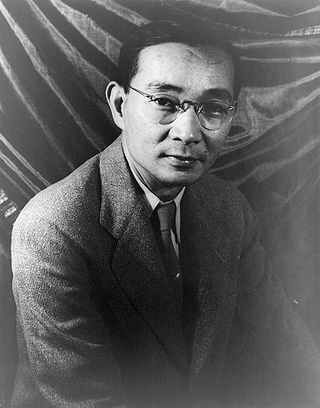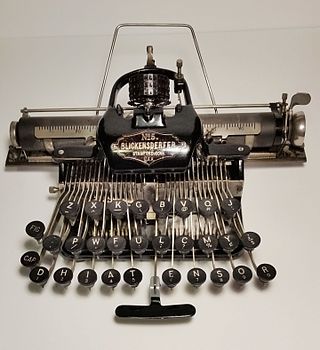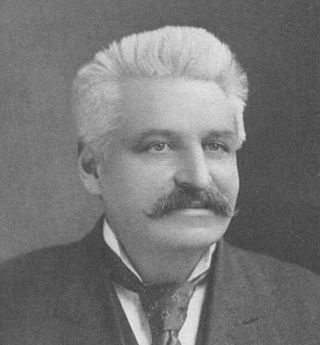Several input methods allow the use of Chinese characters with computers. Most allow selection of characters based either on their pronunciation or their graphical shape. Phonetic input methods are easier to learn but are less efficient, while graphical methods allow faster input, but have a steep learning curve.

A keyset or chorded keyboard is a computer input device that allows the user to enter characters or commands formed by pressing several keys together, like playing a "chord" on a piano. The large number of combinations available from a small number of keys allows text or commands to be entered with one hand, leaving the other hand free. A secondary advantage is that it can be built into a device that is too small to contain a normal-sized keyboard.

QWERTY is a keyboard layout for Latin-script alphabets. The name comes from the order of the first six keys on the top letter row of the keyboard: QWERTY. The QWERTY design is based on a layout included in the Sholes and Glidden typewriter sold via E. Remington and Sons from 1874. QWERTY became popular with the success of the Remington No. 2 of 1878 and remains in ubiquitous use.

A word processor is an electronic device for text, composing, editing, formatting, and printing.

A typewriter is a mechanical or electromechanical machine for typing characters. Typically, a typewriter has an array of keys, and each one causes a different single character to be produced on paper by striking an inked ribbon selectively against the paper with a type element. Thereby, the machine produces a legible written document composed of ink and paper. By the end of the 19th century, a person who used such a device was also referred to as a typewriter.

Lin Yutang was a Chinese inventor, linguist, novelist, philosopher, and translator. He had an informal style in both Chinese and English, and he made compilations and translations of classic Chinese texts into English. Some of his writings criticized the racism and imperialism of the West.

The tab keyTab ↹ on a keyboard is used to advance the cursor to the next tab stop.

Typing is the process of writing or inputting text by pressing keys on a typewriter, computer keyboard, mobile phone, or calculator. It can be distinguished from other means of text input, such as handwriting and speech recognition. Text can be in the form of letters, numbers and other symbols. The world's first typist was Lillian Sholes from Wisconsin in the United States, the daughter of Christopher Sholes, who invented the first practical typewriter.

The Friden Flexowriter was a teleprinter produced by the Friden Calculating Machine Company. It was a heavy-duty electric typewriter capable of being driven not only by a human typing, but also automatically by several methods, including direct attachment to a computer and by use of paper tape.

The Blickensderfer typewriter was invented by George Canfield Blickensderfer (1850–1917) and patented on April 12, 1892. Blickensderfer was a nephew of John Celivergos Zachos, the inventor of the stenotype. Two models, Model 1 and Model 5, were unveiled to the public at the 1893 World's Columbian Exposition in Chicago. The Model 5 was a stripped-down version of the bigger, more complex Model 1. These machines were intended to compete with larger Remington, Hammond and Yost typewriters, and were the first truly portable, full-keyboard typewriters. The design also enabled the typist to see the typed work, at a time when most typewriters were understrike machines that concealed the writing. When Blickensderfer unveiled his small Model 5, its compactness and novel features attracted huge crowds and many orders.

The Oliver Typewriter Company was an American typewriter manufacturer headquartered in Chicago, Illinois. The Oliver Typewriter was one of the first "visible print" typewriters, meaning text was visible to the typist as it was entered. Oliver typewriters were marketed heavily for home use, using local distributors and sales on credit. Oliver produced more than one million machines between 1895 and 1928 and licensed its designs to several international firms.
Olivetti is an Italian manufacturer of computers, tablets, smartphones, printers, calculators, and fax machines. It was founded as a typewriter manufacturer by Camillo Olivetti in 1908 in the Turin commune of Ivrea, Italy.

Lucien Stephen Crandall was an American inventor of typewriters, adding machines and electrical devices. Crandall gave his name to several typewriters, and he was also involved in the development of various machines, such as the project to produce the Hammond design at the Remington factory, or later the International typewriter.

The first practical Japanese typewriter was invented by Kyota Sugimoto in 1915. Out of the thousands of kanji characters, Kyota's original typewriter used 2,400 of them. He obtained the patent rights to the typewriter that he invented in 1929. Sugimoto's typewriter met its competition when the Oriental Typewriter was invented by Shimada Minokichi. The Otani Japanese Typewriter Company and Toshiba also released their own typewriters later.

The IBM Selectric was a highly successful line of electric typewriters introduced by IBM on 31 July 1961.

The Sholes and Glidden typewriter was the first commercially successful typewriter. Principally designed by the American inventor Christopher Latham Sholes, it was developed with the assistance of fellow printer Samuel W. Soule and amateur mechanic Carlos S. Glidden. Work began in 1867, but Soule left the enterprise shortly thereafter, replaced by James Densmore, who provided financial backing and the driving force behind the machine's continued development. After several short-lived attempts to manufacture the device, the machine was acquired by E. Remington and Sons in early 1873. An arms manufacturer seeking to diversify, Remington further refined the typewriter before finally placing it on the market on July 1, 1874.

Dvorak is a keyboard layout for English patented in 1936 by August Dvorak and his brother-in-law, William Dealey, as a faster and more ergonomic alternative to the QWERTY layout. Dvorak proponents claim that it requires less finger motion and as a result reduces errors, increases typing speed, reduces repetitive strain injuries, or is simply more comfortable than QWERTY.

A keyboard layout is any specific physical, visual, or functional arrangement of the keys, legends, or key-meaning associations (respectively) of a computer keyboard, mobile phone, or other computer-controlled typographic keyboard.

Lin Yutang's Chinese-English Dictionary of Modern Usage, compiled by the linguist and author Lin Yutang, contains over 8,100 character head entries and 110,000 words and phrases, including many neologisms. Lin's dictionary made two lexicographical innovations, neither of which became widely used. Collation is based on his graphical "Instant Index System" that assigns numbers to Chinese characters based on 33 basic calligraphic stroke patterns. Romanization of Chinese is by Lin's "Simplified National Romanization System", which he developed as a prototype for the Gwoyeu Romatzyh or "National Romanization" system adopted by the Chinese government in 1928. Lin's bilingual dictionary continues to be used in the present day, particularly the free online version that the Chinese University of Hong Kong established in 1999.
A word processor (WP) is a device or computer program that provides for input, editing, formatting, and output of text, often with some additional features.



















